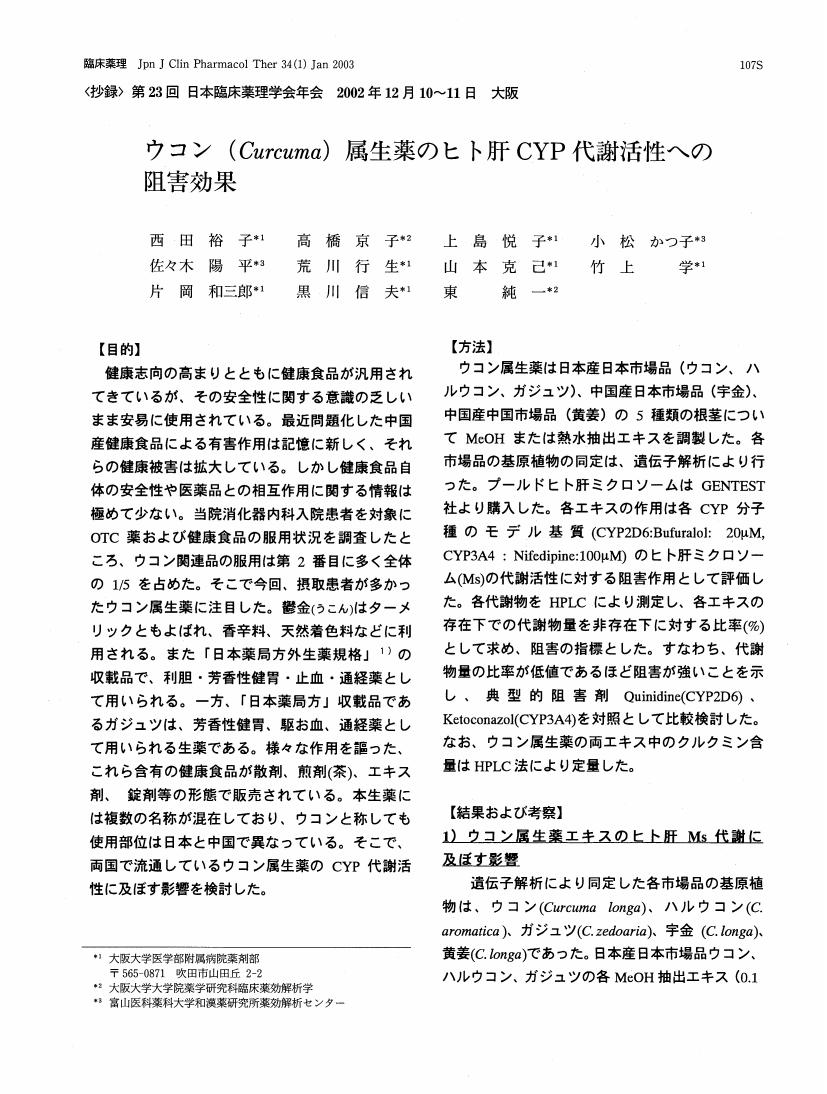- 著者
- 幡生 あすか 戸田 祥平 谷手 紗也香 上島 悦子 高木 達也 上田 幹子
- 出版者
- 日本社会薬学会
- 雑誌
- 社会薬学 (ISSN:09110585)
- 巻号頁・発行日
- vol.39, no.1, pp.2-11, 2020-06-10 (Released:2020-07-01)
- 参考文献数
- 35
- 被引用文献数
- 1
In recent years, one of Japan’s policies for controlling increased medical expenses is promoting self-medication. Owing to their influence on the health of young people, energy drinks (a caffeine-containing beverage) have attracted attention. However, only a few surveys have evaluated their use in Japan. Therefore, we conducted a questionnaire survey on university students on self-medication interest and energy drink use trend, involving 180 students aged 18-26 years. The results showed 28.3% of the students were interested in self-medication and 4.4% were knowledgeable on the self-medication tax system. Additionally, 73.9% of them used over-the-counter (OTC) drugs, especially common cold medicines (65.0%). Further, 77.2% of them consumed energy drinks, mainly to stay awake (61.9%), and most frequently from evening to midnight (54.7%). Furthermore, 26.6% of the students had experienced discomfort or poor health when taking energy drinks, with the most common symptoms being “tachycardia” (n=13) and “sleep disorders” (n=12). Pharmacy and drugstore pharmacists could contribute to caffeine overdose prevention by educating the public on the caffeine content of common cold medications and various foods and drinks such as energy drinks. It is desirable for future studies to investigate in depth the usage of caffeine-containing beverages, including energy drinks.
4 0 0 0 OA 口腔機能に着目した医歯薬連携の必要性
- 著者
- 上田 幹子 仁木 一順 上田 紘子 大石 美奈子 上島 悦子
- 出版者
- 一般社団法人日本医療薬学会
- 雑誌
- 医療薬学 (ISSN:1346342X)
- 巻号頁・発行日
- vol.43, no.6, pp.320-327, 2017-06-10 (Released:2018-06-10)
- 参考文献数
- 8
- 被引用文献数
- 1
Maintaining the oral cavity function is important in the intake of medicine and for the effectiveness of the medication itself. However, little is known about the need for medical, dental and pharmacological cooperation. We conducted a questionnaire survey related to side effects in the oral cavity in community pharmacies (n = 272) near our hospital belonging to the Pharmaceutical Association. We obtained responses from 120 pharmacies (44.1%). We also obtained comments from some dentists and a dental hygienist about the responses. From the survey results, 75%, 60% and 40% of pharmacies have experienced consultation from patients concerning deglutition, dry mouth and gingival hyperplasia, respectively. It was revealed that a lot of pharmacies are consulted by patients about side effects in the oral cavity. Eighty percent of pharmacies alerted patients to bisphosphonate-related osteonecrosis of the jaw. However, many pharmacists were concerned that they didn't know the initial symptoms and when bisphosphonate should be discontinued prior to dental treatment. These dentists commented that it would be better for the patients to consult with a dentist whenever the patients felt discomfort in their oral cavity. In this study, it became clear that pharmacists and dentists need to exchange information and cooperate with each other. Community pharmacists can contribute to appropriate pharmacotherapy by preventing serious adverse effects using the knowledge of oral cavity medications, because patients first consult the pharmacists regarding the medication.
1 0 0 0 OA ダカルバジンの光分解に対する新規遮光カバーの有用性の検討
- 著者
- 森尾 佳代子 津金 麻実子 岡本 禎晃 糀 桂子 田墨 惠子 上島 悦子
- 出版者
- 一般社団法人日本医療薬学会
- 雑誌
- 医療薬学 (ISSN:1346342X)
- 巻号頁・発行日
- vol.39, no.6, pp.381-387, 2013-06-10 (Released:2014-06-10)
- 参考文献数
- 14
- 被引用文献数
- 2 2
Dacarbazine (DTIC) produces adverse reactions including local venous pain during the intravenous injection. DTIC is reported to be photolyzed to produce certain kinds of pain producing substances. 5-diazoimidazole-4-carboxamide (Diazo-IC) is considered to be a causative photolyte of venous pain. A newly designed cover shield has been used at Osaka University Hospital when DTIC is administered for the last 4 years. This shield comprises black cotton and covers both the infusion bag and route of infusion. We evaluated the effectiveness of this new shield against photodegradation of DTIC by determining the concentration of Diazo-IC. DTIC was dissolved with an injection solvent and mixed with 5% dextrose in water. Prepared samples were divided into 3 groups (without shield, infusion bag covered with shield, and infusion bag and infusion route covered with shield) and exposed under natural light conditions indoors. Prepared solutions ran down through the route and those samples were taken before and after passing the route pipe. Diazo-IC in the samples was measured by HPLC. Production of Diazo-IC in the non-covered bag was significantly increased in comparison with that in covered infusion bags. Diazo-IC production in samples after passing through the route was significantly increased compared with that in samples taken before passing through the route of the non-covered shield and covered infusion bag only. For the covered infusion bag and infusion route, the samples taken before and after passing through the route did not show significant differences. These data suggest that the new shield, which almost perfectly covers both the infusion bag and route of infusion, is effective in preventing DTIC photodegradation.
